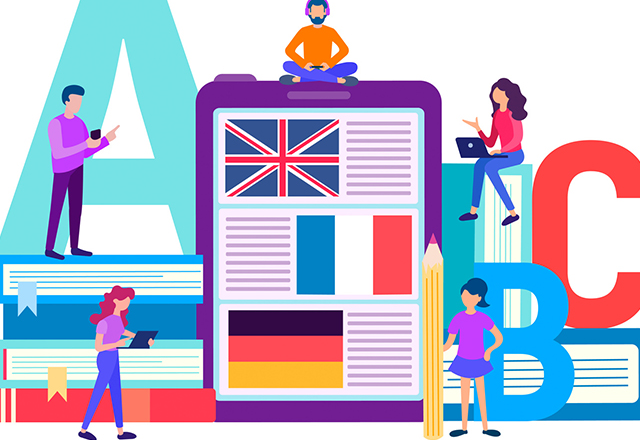You are here
Amid coronavirus, students flock to Kahoot! and Duolingo. Is it the end of language teachers?
By USA Today (TNS) - Apr 08,2020 - Last updated at Apr 08,2020

Photo courtesy of agapesdusud.com
Every day, Massachusetts seventh-grader Kaylyn Wilson takes a break from doing homework online and opens an app on her phone for a half-hour foreign language lesson.
“The boy has three green bikes and an egg,” the 12-year-old announced to her family in French at the start of her third week using the mobile app from Rosetta Stone, the language-learning software giant.
Wilson doesn't yet need to study a language for credit. But during the school shutdowns to contain the coronavirus, her father saw Rosetta Stone advertise free accounts for students – an offer other language-learning software companies have made as well. Wilson decided to give it a go.
“I really like learning French, and it doesn’t feel like a chore to me,” she said.
As children nationwide settle into weeks and months of remote learning, educational technology companies are having a heyday, marketing their products as must-have solutions to keep students with Internet access connected and engaged. Few were poised to do so as well as language-learning software companies, which have spent years honing the digitised, personalised, gamified experience of a self-paced education.
Programmes like Rosetta Stone, Duolingo, Babbel, and Kahoot! have been used in schools for years, with a catch: They're usually paired with a teacher. The tools could supplement foreign-language and English language instruction, but a few schools quietly used them to fully replace a certified educator that was too hard to find or too expensive to hire.
CEOs of the companies have long stressed their software isn't meant to supplant educators. But with hundreds of thousands of new users logging in from home, a global test – at least for this corner of online learning – is underway: Just how well can students learn on their own, through software, without a teacher?
And how much will this digitised education experiment change learning once children eventually return to traditional classes?
“I do think that this is one of those watershed moments,” said Matt Hulett, CEO for Rosetta Stone. The company has added 10,000 to 20,000 new users each day since it dropped subscription fees.
Hulett wouldn’t share exactly how that translated to specific earnings, but he said the first quarter of 2020 stood to be a strong one for Rosetta Stone's consumer business, made of school and student accounts and adult subscribers.
'Technology and teachers are intertwined'
“We believe that teachers and technology are intertwined,” Hulett said. “We don’t believe there’s a self-learning trend that’s going to replace teachers.”
But in this unusual time, marketing materials position the products as the home-schooling solution for the coronavirus epidemic.
"In light of the current COVID-19 situation leaving millions of kids across the US doing their school work from home, the global language & literacy company, Rosetta Stone, is stepping up to help provide those work-from-home parents some relief," the company announced in press materials after it dropped subscription fees for students.
Language education experts praised the companies for providing free resources with no strings attached. But they're concerned an increased reliance on software in lieu of real teachers – in virtual or traditional settings – could check the box for proficiency without giving students all the tools to read, write and understand a new language.
“How you can use language in a limited, computer-based environment is one thing," said Howie Berman, head of the American Council on the Teaching of Foreign Languages. "But once you’re out of that environment, can you actually use the language in a real-world setting?”
Academic researchers applauded the companies as well but said their programmes weren't a blanket solution. The software can't always be adapted for students with disabilities or those who have limited access to the Internet.
"It's important to recognise these resources do not take the place of quality teaching and that not all tools are designed for all types of students," said Kara Dawson, a professor of educational technology at the University of Florida.
How well do language-learning apps work?
In the beginning, most language-learning software focused on the consumer market – average adults who wanted to pick up a new language in their free time, on a home computer or in recent years, on mobile apps.
Rosetta Stone, which started in 1992, was still selling boxes of its iconic yellow CDs to consumers into the start of the 2010s. Now, like other companies, it’s shifted to emphasising subscription-based services that feature speech-recognition. On Rosetta Stone's latest iPhone app, users can point their phones at an object, which the app will then translate into the language the user is learning. The company also has offered to connect paying subscribers with free, live tutors for virtual sessions through the end of June.
For the language-learning companies, selling classroom software is relatively new.
The concept is generally the same across companies: Individual students walk through the exercises to practice grammar and pronunciation, and the software offer teachers feedback about how each student is doing.
Rosetta Stone also offers English literacy services to schools. In 2012, it purchased Lexia Learning, which supplements elementary English instruction and also helps students learning English as a second language.
Before the pandemic, Rosetta Stone was serving 17,000 schools and 4 million students with English literacy and foreign-language services, said Maya Goodall, a company director. That number is now much higher.
Babbel, based in Berlin, Germany, also has offered free access to students during the pandemic and has added more than 50,000 new young users, including around 10,000 new students in the US, a spokesperson said.
There's scant research on the effectiveness of the latest language-learning software – in part because the technology is moving so fast. But for math and reading, a recent review of high-quality studies suggested computer-assisted learning programmes that help students practice specific skills led to big academic gains.
The most effective programmes had key features: They were interactive, allowed students to progress at their own speed and adapted to their abilities, said Phillip Oreopoulos, an economics professor at the University of Toronto and one of the authors of that review. The best programmes also fed data back to teachers about student performance, he added.
Even Oreopoulos downloaded Duolingo for his children, ages 11 and 9, when their Toronto schools shut down three weeks ago.
"They don’t seem to mind spending half an hour a day conjugating verbs in French, so I’m happy about that,” he said. “I don’t know if it’s helping in the long run, but it’s worth trying and keeps them busy.”
Game-based education apps surging
Duolingo entered the language-learning market in 2012 with a game-based online platform and mobile app. And another key feature: It’s free.
In 2015, the company rolled out Duolingo for Schools, which allowed teachers to track the progress of entire classes. It's also free and supported through advertisements.
As of March 19, shortly after the pandemic caused the closure of nearly all schools in America, Duolingo for Schools signups were increasing 425 per cent week-over-week, driven largely by teachers assigning remote work and parents looking for resources to home-school their children, said spokeswoman Michaela Kron.
Carlos-Luis Brown, a Spanish teacher at Wilmington High School in Massachusetts, said he's used Duolingo for at least four years to supplement instruction – it's part of his students' graded homework.
During the shutdowns, he said, Duolingo has become "the most consistent part" of what his students are doing at home.
Kahoot!, another game-based service for world languages and other academic subjects, also offered free premium accounts to teachers and schools through the end of this academic year. During the height of new traffic, the company was getting more than 100,000 new accounts per day, a spokeswoman said.
Few states require foreign language
The sudden spike in language-learning software users comes at a paradoxical time: Few states require students to study a world language.
Just seven states, including New York and Michigan, specifically require one or two years of a foreign language to graduate, according to the latest data compiled by the nonpartisan Education Commission of the States. Twenty-two other states allow for local districts to declare multiple options for students to satisfy the foreign-language requirement, such as by taking computer coding or another humanities credit.
Almost all states reported shortages of foreign language teachers in middle and high school in the 2016-17 school year, according to a federal report.
In 2016, one rural high school in Maine struggling to secure a foreign language teacher instead used the funds to buy a Rosetta Stone class package.
Brown said he used to work for a charter school that wanted to use Rosetta Stone as the curriculum for all its elementary grades. Brown resisted the proposal – he feared it would remove teachers.
"What we're really teaching is culture, and as a byproduct of that, you learn a language," Brown said. "It's a study of a different life and a different way, and the idea that students are able to tell their own story, and hear other people's stories, is critical."
Best of both worlds
Some teachers will continue to incorporate what they see as the best of both worlds: robust, face-to-face instruction as well as games and online tools to keep students engaged – even if it's a struggle in the new world of remote learning.
In a normal year, Richard de Meij, a world language teacher at Hartford Public High School in Connecticut, uses a variety of in-class and virtual tools. Students use an app to engage in controlled, monitored conversations with native Spanish speakers in other countries. They must watch the soap opera "Destinos" online and answer questions about the show. They take quizzes on Kahoot! They can practice on Duolingo for extra credit.
“Duolingo is free and excellent for vocabulary building, but not necessarily communicative skills,” de Meij said.
Now that everyone is at home, de Meij, who speaks eight languages, is teaching by video and encouraging students to stay connected to their studies via online software.
“I think face-to-face learning in a classroom will never go away," he said. "But it's a golden moment for these language tools and learning platforms."
Education coverage at USA Today is made possible in part by a grant from the Bill & Melinda Gates Foundation. The Gates Foundation does not provide editorial input.
Related Articles
FRANKFURT — Smartphone apps that help people learn languages for free or nearly free, a few sentences at a time, are piling pressure on esta
Microsoft Jordan is planning to implement a series of initiatives starting next month to educate secondary school and university students on how to develop apps for Windows.
Philipp Mattheis knew his gaming app was addictive when he realised he kept checking his phone — hooked by the brightly coloured reminders telling him to play again or risk falling from the triple-figure level he had reached.














